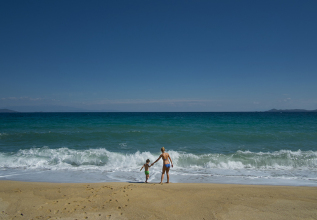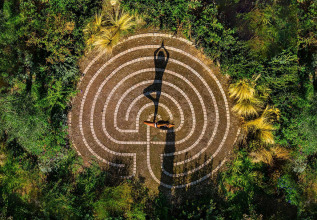4 MIN
TRAVEL TIPS
Delos, a place of gods

 The Persian Wars reached their end and many greek cities - states wanted a greek alliance that would deter any future external threats. In 478 B.C. 150 greek cities - states signed the founding of the "Delian League" under the leadership of Athens. The treasury of the league stood in Delos and all the meetings of the league took place in the same place. Soon, Athens started to take advantage of the members of the "Delian League" and used them for its financial and political goals. As a result, the league's treasury was moved to the Acropolis of Athens in 454 B.C.
The peak of the Athenian abusive tactics was the Delian "Purification". The Athenians opened all the graves in the island of Delos and transferred their burial contents to a pit in the nearby island of Rinia. They, also, decided that all the women in labour and all the dying people should leave Delos and be transferred to Rinia, too. From that moment the Delian people had no motherland, since noone was born or died in the island.
In 425 - 420 B.C. the Athenians seemed to have regretted their mercilless actions and started to built a new temple of Apollo in Delos. The temple was entirely made of white marble and was designed by Callicrates, the architect of Acropolis.
The Persian Wars reached their end and many greek cities - states wanted a greek alliance that would deter any future external threats. In 478 B.C. 150 greek cities - states signed the founding of the "Delian League" under the leadership of Athens. The treasury of the league stood in Delos and all the meetings of the league took place in the same place. Soon, Athens started to take advantage of the members of the "Delian League" and used them for its financial and political goals. As a result, the league's treasury was moved to the Acropolis of Athens in 454 B.C.
The peak of the Athenian abusive tactics was the Delian "Purification". The Athenians opened all the graves in the island of Delos and transferred their burial contents to a pit in the nearby island of Rinia. They, also, decided that all the women in labour and all the dying people should leave Delos and be transferred to Rinia, too. From that moment the Delian people had no motherland, since noone was born or died in the island.
In 425 - 420 B.C. the Athenians seemed to have regretted their mercilless actions and started to built a new temple of Apollo in Delos. The temple was entirely made of white marble and was designed by Callicrates, the architect of Acropolis.
 In the sanctuary of Delos stood two more Apollo's Temples. The older one was, also, constructed by the Athenians during the tyranny of Peisistratos in the late 6th century B.C. This temple was made of stone and housed a colossal "kouros" statue of Apollo. The other Apollo's temple was work of the Delian people. They started building the temple in 476 B.C. and the common treasury of the "Delian League" founded its construction. The temple remained unfinished due to the treasury's relocation but the Delians failed to complete their work even after they left the Delian League in 315 B.C.
The road that connected the harbour to the holy sanctuary, the sacred way, was decorated with marble lion statues. It was called "the terrace of the lions" and all the 19 marble lions were offered to Apollo by the Naxos people around 600 B.C.
In the sanctuary of Delos stood two more Apollo's Temples. The older one was, also, constructed by the Athenians during the tyranny of Peisistratos in the late 6th century B.C. This temple was made of stone and housed a colossal "kouros" statue of Apollo. The other Apollo's temple was work of the Delian people. They started building the temple in 476 B.C. and the common treasury of the "Delian League" founded its construction. The temple remained unfinished due to the treasury's relocation but the Delians failed to complete their work even after they left the Delian League in 315 B.C.
The road that connected the harbour to the holy sanctuary, the sacred way, was decorated with marble lion statues. It was called "the terrace of the lions" and all the 19 marble lions were offered to Apollo by the Naxos people around 600 B.C.
 The imposing statues were guarding the sanctuary and were watching over the thousands of visitors who congregated every 5 years for the "Delia" festival. It was one of the most imporant festivities in ancient Greece equal with "Pythia" in Delphi. Sports and music competitions were held during the "Delia" festival to honour the god of youth and art and special religious events took place in the altar of Apollo, which according to a myth was built by Apollo himself with the left horns of the goats that Artemis caught in mount Kynthos, the only mountain of the island. Today, the remnants of the holy altar are some ruins from the arched building that protected it and remind the visitor that there sprung Apollo's light and glory.
The imposing statues were guarding the sanctuary and were watching over the thousands of visitors who congregated every 5 years for the "Delia" festival. It was one of the most imporant festivities in ancient Greece equal with "Pythia" in Delphi. Sports and music competitions were held during the "Delia" festival to honour the god of youth and art and special religious events took place in the altar of Apollo, which according to a myth was built by Apollo himself with the left horns of the goats that Artemis caught in mount Kynthos, the only mountain of the island. Today, the remnants of the holy altar are some ruins from the arched building that protected it and remind the visitor that there sprung Apollo's light and glory.
Article by museummasters


